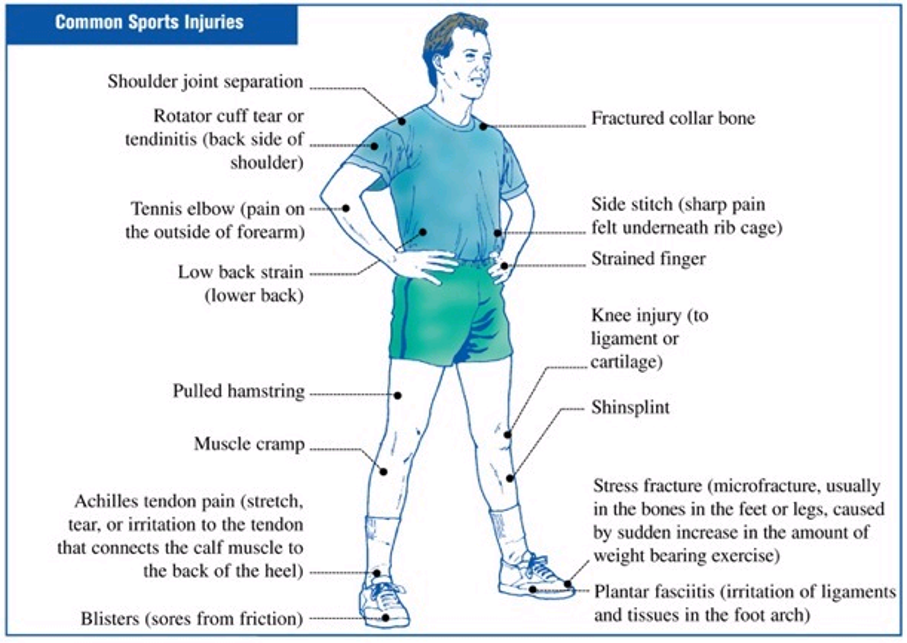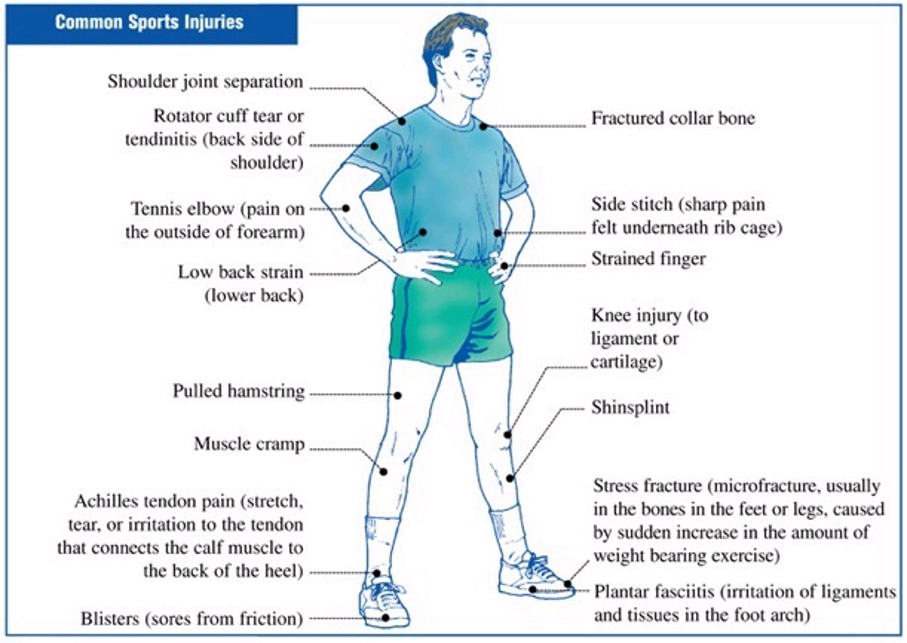Understanding and Managing Common Injuries: A Comprehensive Guide
Injuries are an inevitable part of life, affecting individuals across various activities and environments. Whether you’re an athlete, a worker, or simply going about your daily routine, understanding the nature of injuries, their causes, and effective management strategies is crucial. This article delves into the different types of injuries, their symptoms, preventive measures, and treatments to provide you with an in-depth knowledge base.
Types of Injuries
1. Acute Injuries
Acute injuries occur suddenly and are often the result of a specific trauma or impact. These injuries can happen during sports, accidents, or any physical activity. Common acute injuries include:
- Sprains and Strains: Sprains involve ligaments (tissues connecting bones), while strains involve muscles or tendons (tissues connecting muscles to bones). Symptoms include pain, swelling, bruising, and limited movement.
- Fractures: A fracture is a break in the bone, varying from a thin crack to a complete break. Symptoms include intense pain, swelling, bruising, and deformity.
- Dislocations: This occurs when the bones in a joint are forced out of their normal positions. Symptoms include severe pain, swelling, and immobility of the joint.
- Cuts and Lacerations: These are injuries to the skin and underlying tissues. Symptoms include bleeding, pain, and possible infection.
2. Chronic Injuries
Chronic injuries develop over time, often due to repetitive stress on a particular part of the body. These injuries are common in athletes and individuals engaged in repetitive motions. Common chronic injuries include:
- Tendonitis: Inflammation of a tendon, often due to overuse. Symptoms include pain, tenderness, and stiffness.
- Stress Fractures: Small cracks in the bone caused by repetitive force or overuse. Symptoms include pain that worsens with activity and diminishes with rest.
- Shin Splints: Pain along the shinbone, often due to repetitive stress or overtraining. Symptoms include tenderness, swelling, and pain during exercise.
- Carpal Tunnel Syndrome: A condition caused by pressure on the median nerve in the wrist, often due to repetitive hand movements. Symptoms include numbness, tingling, and weakness in the hand.
Causes of Injuries

Understanding the causes of injuries can help in their prevention. Common causes include:
- Overuse: Repetitive motions can lead to overuse injuries, particularly in athletes and workers performing the same tasks repeatedly.
- Trauma: Accidents, falls, and impacts can cause acute injuries.
- Poor Technique: Incorrect form during physical activities can increase the risk of injury.
- Inadequate Warm-Up: Failing to properly warm up before exercise can make muscles and joints more susceptible to injury.
- Environmental Factors: Slippery surfaces, poor lighting, and unsafe equipment can contribute to injuries.
Symptoms of Injuries
The symptoms of injuries vary depending on the type and severity. Common symptoms include:
- Pain: Ranging from mild discomfort to severe pain.
- Swelling: Localized or widespread swelling in the injured area.
- Bruising: Discoloration of the skin due to bleeding under the skin.
- Limited Mobility: Difficulty moving the affected area.
- Numbness or Tingling: Often associated with nerve injuries.
Prevention of Injuries
Preventing injuries involves taking proactive measures to reduce risks. Key prevention strategies include:
1. Proper Technique
Using the correct technique during physical activities is crucial. This includes:
- Sports: Learning the proper form for exercises and movements.
- Workplace: Following ergonomic guidelines to reduce strain.
2. Adequate Warm-Up and Cool-Down

Warming up before physical activity increases blood flow to muscles, making them more flexible and less prone to injury. Cooling down helps in recovery and reduces muscle stiffness.
3. Use of Protective Gear
Wearing appropriate protective gear, such as helmets, knee pads, and wrist guards, can significantly reduce the risk of injuries.
4. Gradual Progression
Avoid sudden increases in the intensity or duration of activities. Gradually progress to higher levels of activity to allow the body to adapt.
5. Rest and Recovery
Adequate rest and recovery time are essential to prevent overuse injuries. Ensure to get enough sleep and take breaks during activities.
6. Environmental Safety
Maintain safe environments by ensuring good lighting, dry surfaces, and proper equipment maintenance.
Treatment of Injuries
Effective treatment is crucial for recovery and preventing further complications. Common treatment methods include:
1. R.I.C.E. Method
- Rest: Avoid activities that cause pain or may aggravate the injury.
- Ice: Apply ice to the injured area for 20 minutes every 2-3 hours.
- Compression: Use an elastic bandage to reduce swelling.
- Elevation: Keep the injured area raised above heart level.
2. Medications
Over-the-counter pain relievers, such as ibuprofen and acetaminophen, can help manage pain and reduce inflammation.
3. Physical Therapy
A physical therapist can design a rehabilitation program tailored to the specific injury, focusing on restoring strength, flexibility, and function.
4. Surgery
In severe cases, such as complex fractures or major ligament tears, surgical intervention may be necessary to repair the injury.
5. Rehabilitation Exercises
Gradual reintroduction of exercises to strengthen the injured area and restore full functionality.
Special Considerations for Specific Populations
1. Athletes
Athletes are particularly prone to injuries due to the high demands placed on their bodies. For this population:
- Specialized Training: Engaging in sport-specific training can enhance performance and reduce injury risk.
- Periodization: Structuring training programs to include cycles of varying intensity can prevent overtraining and overuse injuries.
- Nutritional Support: A balanced diet rich in essential nutrients supports recovery and overall physical health.
2. Elderly Individuals
The elderly are more susceptible to injuries due to decreased bone density and muscle mass. Key considerations include:
- Bone Health: Ensuring adequate intake of calcium and vitamin D can help maintain bone strength.
- Fall Prevention: Implementing home safety measures, such as installing grab bars and using non-slip mats, can reduce fall risks.
- Regular Exercise: Engaging in weight-bearing and balance exercises can improve muscle strength and coordination.
3. Children and Adolescents
Children and adolescents are also at risk due to their active lifestyles and developing bodies. Important factors to consider are:
- Growth Plate Injuries: Avoiding excessive stress on growing bones is crucial.
- Proper Equipment: Ensuring that sports gear fits correctly and is appropriate for the child’s age and size.
- Supervision: Providing adequate supervision during activities to prevent accidents.
Advanced Treatment Options
1. Regenerative Medicine
Regenerative medicine focuses on repairing or replacing damaged tissues using advanced techniques such as:
- Platelet-Rich Plasma (PRP) Therapy: Using a concentration of a patient’s own platelets to accelerate healing of injured tendons, ligaments, muscles, and joints.
- Stem Cell Therapy: Utilizing stem cells to promote the repair of injured tissues.
2. Minimally Invasive Surgery
Minimally invasive surgical techniques involve smaller incisions, leading to reduced recovery times and less postoperative pain. Examples include:
- Arthroscopy: A procedure that uses a small camera to diagnose and treat joint problems.
- Laparoscopy: A surgical procedure used to examine and operate on the organs inside the abdomen.
3. Advanced Physical Therapy Techniques
Innovative physical therapy techniques can enhance recovery, including:
- Hydrotherapy: Using water to support and resist movements, reducing stress on the body while improving strength and flexibility.
- Electrical Stimulation: Using electrical currents to stimulate muscles and promote healing.
Mental and Emotional Aspects of Injury Recovery
Recovering from an injury is not only a physical process but also a mental and emotional journey. Addressing these aspects can significantly impact recovery outcomes:
1. Psychological Support
- Counseling: Professional counseling can help individuals cope with the emotional impact of their injuries.
- Support Groups: Connecting with others who have experienced similar injuries can provide valuable emotional support.
2. Mental Training
- Visualization Techniques: Imagining successful performance and recovery can enhance physical rehabilitation.
- Relaxation Methods: Techniques such as deep breathing and meditation can reduce stress and improve mental well-being.
3. Setting Realistic Goals
- Short-Term Goals: Focusing on small, achievable milestones can keep motivation high.
- Long-Term Goals: Setting broader objectives for overall recovery and return to normal activities.
Innovations in Injury Prevention
Technological advancements and research are continuously improving injury prevention strategies:
1. Wearable Technology
Wearable devices, such as fitness trackers and smart clothing, can monitor physical activity and provide feedback to prevent injuries. Features include:
- Movement Analysis: Detecting improper form or excessive strain during activities.
- Health Monitoring: Tracking vital signs and activity levels to ensure optimal performance.
2. Biomechanical Analysis
Using advanced imaging and motion capture technology to analyze movement patterns can help identify and correct potential injury risks.
3. Injury Prevention Programs
Developing comprehensive injury prevention programs tailored to specific sports or activities can significantly reduce injury rates. These programs often include:
- Strength and Conditioning: Focused on enhancing overall physical fitness.
- Flexibility Training: Incorporating stretching exercises to improve range of motion.
- Education and Training: Providing information on proper techniques and injury prevention strategies.
The Role of Nutrition in Injury Prevention and Recovery
Proper nutrition plays a vital role in both preventing injuries and facilitating recovery:
1. Anti-Inflammatory Foods
Including anti-inflammatory foods in your diet can help reduce inflammation and promote healing. Examples include:
- Omega-3 Fatty Acids: Found in fish, flaxseeds, and walnuts.
- Antioxidants: Present in fruits, vegetables, nuts, and seeds.
2. Protein for Muscle Repair
Adequate protein intake is essential for repairing damaged muscles. Good sources include:
- Lean Meats: Such as chicken, turkey, and fish.
- Plant-Based Proteins: Like beans, lentils, and tofu.
3. Hydration
Staying properly hydrated supports overall health and recovery. Tips for maintaining hydration include:
- Drinking Water Regularly: Especially during and after physical activities.
- Avoiding Dehydrating Beverages: Such as excessive caffeine and alcohol.
Conclusion
Injuries, whether acute or chronic, require a comprehensive approach to prevention, management, and recovery. By understanding the different types of injuries, their causes, symptoms, and effective treatment options, you can take proactive steps to minimize risks and ensure a speedy recovery. Incorporating proper techniques, adequate nutrition, and psychological support further enhances the healing process, enabling you to return to your activities stronger and more resilient.











Post Comment